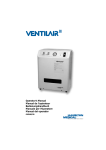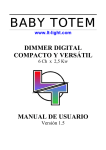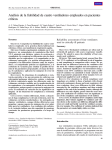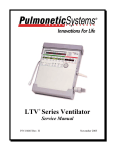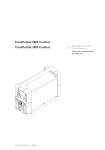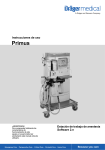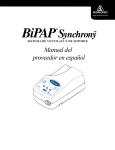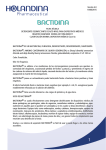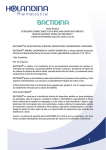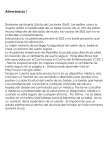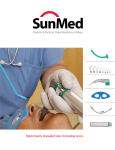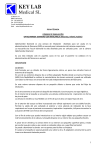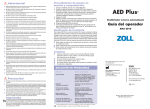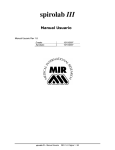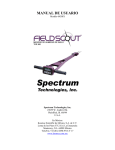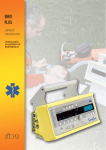Download Order-Nr. 610 562/04
Transcript
Software version 2.xx HAMILTON MEDICAL AG Product Management Via Nova CH-7403 Rhäzüns Phone +41 81 660 60 10 Fax +41 81 660 60 20 Order-Nr. 610 562/04 © November '98 3 Authorized representative according to Medical Device Directive: HAMILTON DEUTSCHLAND GmbH Postfach 110565 D-64220 Darmstadt Germany 4 TABLE OF CONTENTS TABLE OF CONTENTS ............................................................................... 5 IMPORTANT INFORMATION ................................................................... 6 WARNINGS .............................................................................................................................. 6 CAUTIONS ............................................................................................................................... 6 NOTES ..................................................................................................................................... 6 WARRANTY ............................................................................................... 7 LIMITED WARRANTY ................................................................................................................. 7 USER/OWNER RESPONSIBILITY .................................................................................................. 8 INSTALLATION INSTRUCTION ................................................................. 9 HARDWARE ............................................................................................................................. 9 NOTE ....................................................................................................................................... 9 SETTING THE INTERFACE .......................................................................................................... 9 OPERATING INSTRUCTION .................................................................... 10 NAVIGATING .......................................................................................................................... 10 SCREEN DIAGRAM ................................................................................................................. 11 NOTE ..................................................................................................................................... 11 USER’S INTRODUCTION ......................................................................... 12 THE MONITOR SCREEN ........................................................................................................... 12 THE WAVEFORM SCREEN ....................................................................................................... 13 REAL TIME ............................................................................................................................. 13 PRESSURE WAVEFORMS ......................................................................................................... 16 X-Y PLOTS ............................................................................................................................ 17 FLOW-VOLUME LOOP ............................................................................................................ 17 PRESSURE-VOLUME CURVE .................................................................................................... 18 CLINICAL APPLICATIONS ....................................................................... 19 VOLUME LOSS ...................................................................................................................... 19 SECRETIONS .......................................................................................................................... 19 AUTOPEEP ............................................................................................................................. 20 BRONCHODILATOR THERAPY .................................................................................................. 21 DYS-SYNCHRONY .................................................................................................................. 22 COMPLIANCE ........................................................................................................................ 23 PCV ....................................................................................................................................... 24 SCREEN OPTIONS AND CONFIGURATIONS .......................................... 26 OVERLAP ............................................................................................................................... 26 FREEZE PLOT .......................................................................................................................... 26 BUFFER .................................................................................................................................. 27 NOTE ..................................................................................................................................... 27 TECHNICAL DETAILS............................................................................... 28 SCHEMATIC DIAGRAMS ......................................................................................................... 28 TECHNICAL SPECIFICATIONS .................................................................................................. 28 ORDERING SPARE PARTS ........................................................................................................ 28 SERVICE ................................................................................................................................. 28 NOTES ...................................................................................................... 30 MANUAL DEL OPERADOR ........................................................... 31 5 IMPORTANT INFORMATION LEONARDO S displays the ventilation parameters and graphs received from the AMADEUS ventilator. LEONARDO S is not a life supporting device. The AMADEUS ventilator is intended for use by properly trained personnel under the direct supervision of licensed medical physicians only. In the USA, federal law restricts this device to sale by or on the order of a physician. WARNINGS If the patient ventilation screen fails any of the tests described in this manual it must be removed from service. DO NOT return the unit to service until all repairs have been completed and all Functional Tests are acceptable. DO NOT use the LEONARDO S patient ventilation screen in conjunction with anaesthetics or in an explosive atmosphere. DO NOT connect or disconnect the LEONARDO S to the AMADEUS ventilator while the ventilator is connected to a patient. LEONARDO S patient ventilation screen. The screen must be located a sufficient distance from transmitting devices to avoid electromagnetic interferences causing interruption. CAUTIONS DO NOT attempt to sterilize the LEONARDO S patient ventilation screen. NOTES Pressures are indicated on the LEONARDO S patient ventilation screen in cmH2O. The pressure unit millibar (mbar) is used by some institutions instead of cm H2O. Since 1 mbar equals 1.016 cmH2O they may be used interchangeably at the pressures normally used on patients. 1 hPa = 1 mbar ~ 1 cmH2O DO NOT attempt service procedures. Service may only be performed by HAMILTON MEDICAL authorized personnel. Only original manufacturer or manufacturer recommended parts and accessories should be used. Any attempts to modify the hardware or software of this device without the express written approval of HAMILTON MEDICAL will void all warranties and liabilities. The LEONARDO S ventilation screen is in compliance with the IEC 601-1-2 regarding EMC. DO NOT use cellular phones or other active transmitting devices in the immediate vicinity of the 6 This sign on the LEONARDO S patient ventilation screen means that there is more information concerning that operational feature in this Manual. The original LEONARDO S patient ventilation screen shipping container must be retained to prevent damage if the instrument ever needs to be shipped. If this carton has been misplaced, contact your official HAMILTON MEDICAL distributor for a replacement. Follow all local, state and federal regulations with respect to environmental protection when disposing the electronic device or parts of it. WARRANTY LIMITED WARRANTY Furthermore, in no event shall HAMILTON MEDICAL be liable for incidental or consequential damages, either direct or contingent. HAMILTON MEDICAL warrants each PRODUCT sold by it to be free from defects in material and workmanship for a period of one year from the date of delivery ex works when operated properly under conditions of normal use for which the product is intended. Disposable items are not covered under this warranty. This Limited Warranty shall be void and not apply: Disposable items are single or limited use products normally required for proper operation of PRODUCT. If any defect in a PRODUCT sold occurs during the warranty period, HAMILTON MEDICAL, at its option, will repair or replace the defective PRODUCT or the respective part of it unless agreed to in writing by HAMILTON MEDICAL or unless specific laws in certain countries foresee an extended product liability. THIS WARRANTY DESCRIBED IN THIS AGREEMENT IS IN LIEU OF ANY AND ALL OTHER WARRANTIES. THE PARTiES AGREE THAT THE IMPLIED WARRANTIES OF MERCHANTABILITY AND FITNESS FOR A PARTICULAR PURPOSE AND ALL OTHER WARRANTIES, EXPRESS OR IMPLIED, ARE EXCLUDED FROM THIS AGREEMENT. EXCEPT AS STATED ABOVE, HAMILTON MEDICAL SHALL NOT BE LIABLE FOR ANY DAMAGES, CLAIMS OR LIABILITIES INCLUDING, BUT NOT LIMITED TO, PERSONAL BODILY INJURY, OR INCIDENTAL, CONSEQUENTIAL, OR SPECIAL DAMAGES. HAMILTON MEDICAL shall have no obligations or liabilities in connection with the PRODUCT other than as provided herein, including without limitation any and all obligations and/or liabilities for alleged negligence, or for strict liability. a. If the PRODUCT has not been installed and connected in accordance with the instructions furnished by HAMILTON MEDICAL; b. If no evidence is present that the occurrence of damage/repair is within the certified warranty period; c. If the serial number has been altered, effaced or removed and there is no bill of sale or evidence to verify the PRODUCT‘s purchase date; or d. To defects arising from misuse, negligence or accidents, or from repair, adjustment, modification or replacement made outside HAMILTON MEDICAL‘s factories or other than an authorized service centre or authorized service representative. e. To product that has been mechanically or electronically altered without specific written authorization from HAMILTON MEDICAL. Replacements and/or repairs furnished under this Limited Warranty do not carry a new warranty, but carry only the unexpired portion of the original Limited Warranty. The terms of this Limited Warranty may not be varied by any person, whether or not purporting to represent or act on behalf of HAMILTON MEDICAL. To obtain service under this Limited Warranty, claimant must promptly notify the nature of the problem and the serial number and date of purchase of the PRODUCT. If HAMILTON MEDICAL determines that the repair is required under this Limited Warranty, the defective PRODUCT or respective part must be returned to HAMILTON MEDICAL‘s factory or authorized service centre. Item(s) must be properly packaged, insured and shipped to HAMILTON MEDICAL, postage/freight paid by claimant. 7 USER/OWNER RESPONSIBILITY The HAMILTON MEDICAL PRODUCTS are designated to function as described in the Operator’s Manual. The user(s) of this equipment should not use parts that have failed, exhibit excessive wear, are contaminated, or otherwise ineffective. The PRODUCTS should not be modified. The user/owner of these PRODUCTS shall have the sole responsibility and liability for any injury to persons or damage to property (including the PRODUCT) resulting from: a. Operation not in accordance with the supplied operating instructions; b. Maintenance not in accordance with authorized maintenance/operating instructions; c. Maintenance by anyone other than a factory authorized service representative; d. Modification of the equipment or accessories; e. Use of damaged, unauthorized, or unapproved components and accessories. 8 INSTALLATION INSTRUCTION HARDWARE 1. Install the mounting arm as shown on the drawing beside. 2. Tighten mounting arm to the screen. 3. Plug screen on either side of the AMADEUS as shown. 4. Connect the RS 232 of the screen with the ventilator interface by the delivered cable. 5. Connect screen to main. SETTING THE INTERFACE LEONARDO S will take some default settings from the ventilator interface card, i.e. default language, date and time. Please see AMADEUS operator’s manual chapter 11 for instructions how to set the interface. Following parameters should be set: Interface parameter Setting Ventilator ID No. NOTE 1 English 2 German 3 n.n. 4 Italian 5 Spanish xx Day Month xx Month Year xx Year Day Switch on the ventilator first to transfer date, time and language setting immediately. Switching on LEONARDO S first will result in English as default and delayed transfer of date and time. LEONARDOS parameter Hours xx Hours Minutes xx Minutes 9 OPERATING INSTRUCTION NAVIGATING LEONARDO is constructed in a very fluid manner. Changing from one screen to another is accomplished with the keyboard function keys, F1 through F8. The menu at the bottom of each screen defines the options controlled by each function key. The numbers within each menu block refer to the corresponding keyboard function key. If you've selected the wrong function key, press the Esc key (top left on the computer keyboard). The Esc key cancels keyboard selections or changes the current screen to the previous screen. In most areas of the LEONARDO program, the function key F7 will return the display to the start, the Monitor Screen. 10 SCREEN DIAGRAM The diagram is showing the basic structure of the LEONARDO software. Monitor screen Utility Plot Trends Trend curves Trend data Waveform screen Real Time X-Y plot Buffer NOTE All data date, time andbuffers are only stored as long as the screen is connected to the main and will be lost with power loss. 11 USER’S INTRODUCTION Mechanical ventilation involves the flow of gas in response to altering pressure in order to effect a change in lung volume. Monitoring flow, pressure and volume enhances the ability of the clinician to optimize ventilatory support. LEONARDO monitors and displays flow, pressure and volume delivered by the Hamilton Medical VEOLAR and AMADEUS series ventilators. The display may be customized based on the clinician's needs and preferences. The clinician can display all waveforms simultaneously or choose to isolate on a single breath. The monitored data is digitally saved and archived under the patient's name. It may be retrieved and reviewed at any time in the future. THE MONITOR SCREEN LEONARDO displays the Monitor Screen at the initiation of the program. The Monitor Screen digitally displays patient data as well as alarm and ventilation parameter settings. Control Settings indicate the position of the ventilator control knobs. These are the patient's set ventilation parameters. Alarm Settings show the position of the alarm control knobs. This pocket guide is intended to introduce the clinician to respiratory mechanics monitoring, including the graphical display of flow, pressure and volume waveforms. Active alarms will be displayed in this box. Monitored Parameters displays and continuously updates monitored and calculated data. Use the keyboard function keys F1 through F8 to activate the menu options. 12 THE WAVEFORM SCREEN REAL TIME LEONARDO uses the Waveform Screen to graph flow, pressure and volume. Real Time refers to a parameter plotted against time. X-Y Plot refers to a parameter plotted against a different parameter. Pressing F6 START from the Monitor Screen selects the following waveform option screen. The Waveform screen displays tidal volumes, flowrates and pressures. Real time refers to the graphic display as the breath occurs. For example, as the flow sensor measures volume entering the patient's airway, LEONARDO graphs the volume tracing simultaneously. Real Time Select the desired parameter with the F1-F4 Menu keys. Pressing the key once selects the parameter, press again to cancel the selection Selected parameters to be plotted will be displayed in the adjacent box and highlighted in the menu. X-Y Plot The selected parameter(s) are graphed in real time. Timing notches are placed at 1 second increments. The versatility of the LEONARDO program allows the operator to customize the screen to individual needs. Volume, flow and pressure may be viewed simultaneously, individually or in combination. Additionally, time sweeps, etc., can be configured to the user's needs. Press F6 START to go to the Waveform Screen. 13 The Waveform Screen provides the clinician with a great deal of information. Ventilator and spontaneous respiratory rates, peak flow rates, inspiratory and expiratory times, peak pressures, I:E ratios, the presence of autoPEEP, imposed work of breathing, bronchodilator response and pulmonary mechanics can all be extrapolated from LEONARDO waveform screens. Inspiratory Expiratory Time Time Inhaled Tidal Volume Peak Flow Rate Peak airway pressure AUTOSCALE is used to configure the displayed graphs. When selected, AUTOSCALE will scale each parameter tracing so it incorporates 80% of the available vertical block space. MONITOR is used to return to the Monitor Screen. Exhaled Tidal Volume Flow Pattern AutoPEEP detection Spontaneous efforts PEEP LEONARDO allows the clinician to view real time waveforms individually or in combination. The waveform display screen contains the parameters which are selected for viewing. CHANGE PARAM. is used to select volume, flow or pressure tracings. CHANGE SCALE is used to configure the viewing screen. BUFFER OPERAT. is a screen save operation. It allows the user to save or delete waveform screens. OVERLAP is used to superimpose tracings atop one another. FREEZE PLOT is used to freeze a complete screen. This gives the user the ability to obtain specific digital readings of the displayed parameter(s). 14 Volume is highlighted by pressing the F1 key. Pressing the F1 key a second time will clear the Volume selection. Similarly, Flow (F2), Pressure (F3) or Opt Pres (F4) are selected and cleared in the same manner. Once the desired parameters have been selected, press F6 START to proceed to the Waveform Screen. LEONARDO graphs the volume measured by the flow sensor. This provides the clinician with precise volume measurements entering and exiting the patient's airway. Figure 1 shows a volume tracing of a mandatory ventilator breath. There are no spontaneous breaths present. Figure 2 shows spontaneous breaths interspersed with mandatory SIMV breaths. Figure 1 Figure 3 illustrates a typical Flow waveform of a mandatory ventilator breath. Inspiratory and expiratory flow are separated horizontally. The shape of the inspiratory flow waveform is a function of the set ventilator flow pattern or by the patient's spontaneous breathing pattern. Figures 3 and 4 illustrate mandatory ventilator breaths and patient spontaneous breaths. Figure 3 Insp. Flow Peak Flow Exp Flow Figure 2 Spontaneous Volumes Set Ventilator Volumes Figure 4 Ventilator breath Spont. breaths 12 15 PRESSURE WAVEFORMS The shape of a pressure waveform varies with ventilator/patient characteristics. The set flow pattern, peak flow rate, patient circuit, artificial airway and impedance characteristics of the patient's airway all contribute to the shape of a pressure waveform. Figure 5 illustrates how varied flow patterns alter the shape of the pressure trace. Figure 6 is a pressure waveform of a mandatory ventilator breath. The peak pressure was 25 cm H2O and the PEEP level was 6 cm H2O. Figure 7 illustrates spontaneous breaths interspersed with SIMV breaths. Figure 7 Ventilator Spont. Trigger efforts Square Accelerating Decelerating Sine Flow Pattern Pressure Trace Figures 6 and 7 are LEONARDO pressure tracings of ventilator and spontaneous breaths. Figure 6 Peak pressure PEEP 16 X-Y PLOTS X-Y Plots graph parameter against parameter. This differs from Real Time graphs which plot parameter(s) on the vertical axis and time on the horizontal axis. X-Y Plots can be Flow-Volume, Pressure-Volume or Flow-Pressure tracings. Figures 8 and 9 are X-Y Plots of flow and volume, Flow-Volume Loops. Flow is on the vertical axis and volume is on the horizontal axis. Movement of the tracing on a vertical plane (up or down) records inspiratory and expiratory flow. Horizontal movement (side to side) traces inhaled and exhaled volumes. Flow-Volume loops are useful in determining the efficacy of bronchodilator therapy. FLOW-VOLUME LOOP Figure 8 Inspiration Exhalation Figure 8 is a Flow-Volume loop of a volume limited ventilator breath. The shape of the flow tracing indicates the set ventilator flow pattern is a square wave and the tidal volume 600 ml. The peak flow rate is 35 lpm. Figure 9 Inspiratory Flow Expiratory Flow Inspiratory Volume Expiratory Volume Figure 9 is a Flow-Volume loop of an unsupported spontaneous breath. Note the shape of the inspiratory flow pattern is somewhat sinusoidal. The peak flow rate occurs slightly before mid-inspiration which is typical of a spontaneous breath through an artificial airway. 17 PRESSURE-VOLUME CURVE Mandatory ventilator breath Figure 11 Pressure-Volume curves illustrate the relationship between the delivered tidal volume and the related pressure changes. LEONARDO traces the tidal volume and airway pressure during inspiration and exhalation. The relationship of pressure to volume reflects compliance, resistance and imposed work of breathing. Figure 10 illustrates a typical mandatory ventilator breath. Exhalation Inspiration Figure 10 Tidal Volume Peak Pressure Spontaneous breath Start Inspiration Exhalation Mandatory ventilator breaths produce a tracing which begins with positive pressure. Positive pressure creates a counterclockwise rotation (Figure 11). Figure 12 illustrates the clockwise rotation of negative pressure created by a patient's spontaneous breath. 18 CLINICAL APPLICATIONS VOLUME LOSS SECRETIONS LEONARDO uses the flow sensor for its volume monitoring. Therefore, volume lost distal to the patient's artificial airway is easily detected and quantified. Secretions may produce a sawtooth effect on the expiratory trace of a flow-volume loop. Figure 13 depicts volume lost due to a persistent cuff leak, bronchopulmonary fistulae, etc. The inhaled tidal volume is 700 ml. The exhaled volume plateaus at 200 ml, which means Figure 14 depicts a flow-volume loop with a pronounced sawtooth pattern during exhalation. Jubran, Tobin et al reported the presence of a Figure 14 Figure 13 that 700 ml entered the patient's airway but only 500 ml returned. Volume lost due to the cuff leak was 200 ml. Note the only parameter selected for display was volume. LEONARDO allows the user to adapt the screen to the clinical importance of each patient situation. sawtooth pattern strongly suggested the likelihood of endobronchial secretions while the absence of the sawtooth pattern indicated secretions were unlikely to be present. The ability to use graphic waveforms to predict when suctioning is required may reduce the frequency of tracheal suctioning and its associated hazards. 19 AUTOPEEP Figure 16 Detecting autoPEEP is simplified with the use of LEONARDO. AutoPEEP is the presence of inadvertent positive pressure within the lung at the end of exhalation. Graphically, autoPEEP manifests itself by the presence of flow at the end of an expiratory phase. Figure 15 shows no autoPEEP as illustrated by the expiratory flow returning to zero during the expiratory cycle. Figure 15 Expiratory flow does not return to zero Spontaneous breathing may make detecting autoPEEP difficult due to the patient's breathing pattern. Figure 17 illustrates a spontaneously breathing patient. The expiratory flow tracing doesn't completely return to zero flow at end exhalation. This is a common presentation during spontaneous breathing and may not indicate the presence of autoPEEP. Figure 17 Expiratory flow returns to zero Conversely, the expiratory flow in Figure 16 does not return to zero prior to the next inspiratory cycle indicating the presence of autoPEEP. 20 Spontaneously breathing patients with autoPEEP will often forcibly reduce the autoPEEP by "decompression". Decompression refers to the patient exhaling more volume than inhaled. Decompression is identified graphically by the volume tracing periodically dropping below baseline. Figure 18 illustrates a decompression breath by a spontaneously breathing patient. Figure 18 BRONCHODILATOR THERAPY Flow-volume loops may be helpful gauging the effects of bronchodilator therapy. Increased airway diameter in response to bronchodilator therapy may produce higher expiratory flow rates. Figure 19 is a flow-volume loop depicting an improved expiratory flow trace following bronchodilator therapy. Figure 19 Decompression Breath 1 Breath 2 The regular appearance of lung decompression in a spontaneously breathing patient suggests the presence of autoPEEP. The addition of preset PEEP may benefit the spontaneously breathing patient where autoPEEP is suspected. Using the OVERLAP function , two flow volume loops are graphed on the same screen. Breath 1 shows a peak expiratory flow rate of 60 lpm and a flat expiratory flow loop indicating high resistance. Breath 2 shows a peak expiratory flow of 80 lpm and an expiratory flow loop indicating reduced resistance. 21 decelerating flow pattern will provide a 50% higher peak flow rate compared to a square wave at the same inspiratory time. DYS-SYNCHRONY Figure 21 Patient ventilator dys-synchrony occurs when the ventilator fails to match the patient's spontaneous breathing pattern. Dys-synchrony may be due to excessive patient ventilatory drive, autoPEEP or by an incorrectly set ventilator. Patient ventilator dys-synchrony increases the patient's work of breathing and can lead to fatigue and failure to wean. Figure 20 illustrates patient ventilator dyssynchrony due to an incorrectly set ventilator. Figure 20 Ventilator Peak Flow Patient Peak Flow The patient's spontaneous peak flow rates exceed the ventilator peak flow rates during the mandatory ventilator breaths. The significant drop in pressure (shaded areas) indicates an increase in the patient's work of breathing. Compare the spontaneous breaths to the mandatory ventilator breaths. When the patient triggers the SIMV breaths, the ventilator responds with a square wave flow pattern at a preset flowrate of 40 lpm. The patient is attempting to inhale at 60 - 70 lpm, creating a large negative pressure deflection (shaded areas) and excessive imposed work of breathing. Figure 21 represents action taken to correct patient ventilator dys-synchrony. The SIMV breaths were reconfigured to a decelerating flow pattern. A 22 When the patient triggers the SIMV breaths, the ventilator responds with the higher peak inspiratory flow rate of the decelerating curve. The resulting synchrony between the patient and the ventilator reduces the imposed work of breathing. COMPLIANCE Figure 23 Pressure Volume curves depict the relationship between generated pressure and delivered volume. Compliance changes can be viewed with pressure volume curves. Figure 22 is a pressure volume curve of an SIMV breath. Figure 22 Compliance changes during volume ventilation result in a change in pressure. Compliance changes during pressure ventilation result in a change in volume. Figure 24 illustrates changes in volume produced by changes in compliance. Figure 24 Points ABC represent inspiration, points CDA represent exhalation. The slope AC represents total compliance. An improvement in compliance would result in the slope AC becoming more upright, while a decrease in compliance, Figure 24, results in the flattening of the AC slope. Utilizing the compliance slope of pressure volume curves can be an advantageous method of determining "Best PEEP". 23 Figure 26 PCV Decreased Compliance PCV is a pressure constant, volume variable mode of ventilation. During PCV, inspiratory flow is automatically regulated to maintain a constant airway pressure. The tidal volume is variable and can change dramatically with fluctuations in the patient's lung compliance, airway resistance and with ventilator circuit dynamics. Increased Compliance Breath 3 Constant Pressure Figure 25 Pressure Constant Figure 25 graphically illustrates PCV. Pressure rises rapidly at the initiation of inspiration and is maintained at the preset level for the duration of inspiratory cycle. Flow is continuously regulated by the ventilator's computer to maintain the preset pressure. The initial peak flow is high to rapidly achieve the preset pressure, flow is then regulated to maintain the pressure for the duration of inspiration. Fluctuations in the patient's compliance will produce tidal volume changes during PCV. 24 Figure 26 illustrates how compliance can increase and decrease the delivered tidal volume during PCV. A drop in compliance during the second breath reduced the tidal volume. The flow tracing shows flow returning to zero halfway through the inspiratory cycle. The tidal volume was delivered during the first half of the inspiratory cycle, the remaining half is effectively a breath hold. An increase in compliance produced a larger delivered tidal volume during Breath #3. The flow tracing doesn't quite return to zero at end inspiration. Increasing inspiratory time will produce a slightly larger tidal volume until pressure equilibration occurs. Adjusting the inspiratory time may also change the delivered tidal volume during PCV. This occurrence can be predicted by observing the flow tracing. When pressure equilibration has occurred between the ventilator and the patient's airway, inspiratory flow will decelerate to zero and volume delivery will cease. Increasing the inspiratory time when pressure equilibration has been reached will not result in an increased tidal volume. Figure 27 Increasing Tidal Volume Increasing Inspiratory Time Conversely, if pressure equilibration has not occurred, increasing or decreasing inspiratory time will result in an increased or decreased tidal volume. Figure 27 illustrates how volume will change in response to inspiratory time when pressure equilibration has not occurred. Pressure control ventilation can be an assist control mode or an SIMV mode. PCV-CMV is an assist control mode. Any spontaneous efforts by the patient will trigger full, pressure controlled breaths at the preset pressure and inspiratory time. Figure 28 PCV-SIMV is an IMV mode of pressure ventilation. A number of pressure controlled breaths are preset. Between the pressure controlled breaths, the patient may breathe spontaneously at volumes and inspiratory times based on the patient's efforts. Additionally, the spontaneous breaths may be pressure supported. Figure 28 illustrates PCV-SIMV. The spontaneous breaths are pressure supported at 10 cm H2O. Note the similarity in the decelerating flow and the square pressure waveform between the pressure controlled and the pressure supported breaths. 25 SCREEN OPTIONS AND CONFIGURATIONS OVERLAP FREEZE PLOT F4 OVERLAP. Superimposes tracings atop one another. The standard (without OVERLAP highlighted) LEONARDO graphic trace will erase any existing trace as it sweeps across the screen. Selecting OVERLAP will retain the current graphic trace and superimpose the next trace above the existing trace. Figure 29 illustrates the OVERLAP function. F5 FREEZE. Freezes the graphics screen and obtains digital data on the displayed parameters. When F5 FREEZE PLOT is pressed, the screen cursor will continue until it completes its screen sweep. When the cursor reaches the end of the screen, the computer freezes the existing image and recalls a moveable cursor as depicted in Figure 30. Figure 29 Figure 30 Before and after bronchodilator flow-volume curves were superimposed on one another. OVERLAP can assist the clinician in establishing bronchodilator therapy efficacy during mechanical ventilation. The right and left keyboard arrows can maneuver the cursor over the frozen image. Each parameter will display a numeric box which will record the value from wherever the cursor is placed. F5 FREEZE PLOT. Freezes the viewing screen. Freeze plot can be useful for quantitating autoPEEP and pulmonary function maneuvers such as vital capacity and inspiratory force. 26 BUFFER BUFFER OPERAT. Allows the clinician to store and retrieve graphic waveforms. Function key F3 of the waveforms menu screen accesses the save and retrieve options. Pressing F3 BUFFER OPERAT. immediately freezes the waveform screen and recalls the BUFFER OPERAT. submenu. To save the current screen, press F4, SAVE BUFFER. A text block will appear asking for a name for the saved screen. A name may be any combination of 8 numbers. To retrieve a saved waveform screen, press function key F2, LOAD BUFFER. A text block identical to the SAVE BUFFER text block will appear asking for the identification of the saved screen. Type in the name exactly as it appears in the block. F5 DEL. BUFFER. Removes unwanted buffer files from the memory. To retrieve a saved waveform screen, press function key F2, LOAD BUFFER. A text block identical to the SAVE BUFFER text block will appear asking for the name of the saved screen. Type in the name exactly as it appears in the block. All stored data will be lost the moment the screen is switched off. NOTE When a waveform screen has been saved, LEONARDO saves all the volume, pressure and flow data available. This allows LEONARDO to configure any waveform screen with the saved data. For example, if the waveform screen saved was a flowvolume curve, it can be retrieved as a flow-volume curve, a pressure-volume curve, a real-time volume tracing or as any waveform format. To retrieve a buffer file in a specific waveform format, first configure the screen to the desired waveform and then use F2 LOAD BUFFER to retrieve the file. 27 TECHNICAL DETAILS SCHEMATIC DIAGRAMS Please send the screen to HAMILTON MEDICAL for repair. For any other cases these two diagrams shall be helpful for diagnostics. TECHNICAL SPECIFICATIONS 10.4’’ colour screen, 640 x 480 pixel RS 232 C, galvanic isolated U 100 - 240 VAC + 10%, 47 - 63 Hz P 25 VA W x D x H 350 x 120 x 250 mm weight approx. 6 kg Environmental conditions: Operating 5 to 35°C, 10 to 90% r.H. Transport and storage -20 to 60°C, 10 to 90% r.H. ORDERING SPARE PARTS Please provide us with serial number of screen ( SN) and the detailed product code such as : „SV-Kabel primär 32 12 427“. SERVICE Do not open the metal covers of the screen. Running the instrument with opened metal cover may cause dangerous voltages. Return it to HAMILTON MEDICAL for repairs. 28 29 NOTES 30 ÍNDICE ÍNDICE ......................................................................................................... 31 INFORMACIÓNIMPORTANTE .......................................................................... 32 ADVERTENCIAS ..................................................................................................................... 32 PRECAUCIONES .................................................................................................................... 32 NOTAS .................................................................................................................................. 32 GARANTÍA ................................................................................................... 33 GARANTÍA LIMITADA ............................................................................................................ 33 RESPONSABILIDAD DEL USUARIO O PROPIETARIO ................................................................. 34 INSTALACIÓN ............................................................................................... 35 HARDWARE ........................................................................................................................... 35 NOTA .................................................................................................................................... 35 CONFIGURACIÓN DE LA INTERFAZ ........................................................................................ 35 OPERACIÓN ................................................................................................. 36 DESPLAZAMIENTO POR LAS OPCIONES ................................................................................. 36 DIAGRAMA DE PANTALLAS ................................................................................................... 37 NOTA .................................................................................................................................... 37 INSTRUCCIONES PARAEL USUARIO .................................................................. 38 LA PANTALLA DE MONITOR ................................................................................................... 38 LA PANTALLA FORMA DE ONDA ........................................................................................... 39 TIEMPO REAL ........................................................................................................................ 39 FORMAS DE ONDA DE PRESIÓN ............................................................................................ 42 TRAZADOS X-Y .................................................................................................................... 43 BUCLE DE FLUJO Y VOLUMEN ............................................................................................... 43 CURVA DE PRESIÓN Y VOLUMEN .......................................................................................... 44 APLICACIONESCLÍNICAS ................................................................................ 45 PÉRDIDA DE VOLUMEN ......................................................................................................... 45 SECRECIONES ....................................................................................................................... 45 AUTOPEEP ............................................................................................................................. 46 TERAPIA DE DILATACIÓN BRONQUIAL ................................................................................... 47 FALTA DE SINCRONÍA ............................................................................................................ 48 COMPLIANCIA ...................................................................................................................... 49 PCV ....................................................................................................................................... 50 OPCIONES Y VALORES DE LA PANTALLA ........................................................... 52 OVERLAP (SUPERPOSICIÓN) ................................................................................................... 52 FREEZE PLOT (CONGELAR) ..................................................................................................... 52 BUFFER (HISTORIAL) ............................................................................................................... 53 NOTA .................................................................................................................................... 53 DETALLESTÉCNICOS ...................................................................................... 54 DIAGRAMAS DE CONEXIONES .............................................................................................. 54 ESPECIFICACIONES TÉCNICAS ............................................................................................... 54 PEDIDOS DE RECAMBIOS ...................................................................................................... 54 SERVICIO TÉCNICO ................................................................................................................ 54 NOTAS ......................................................................................................... 56 31 INFORMACIÓN IMPORTANTE LEONARDO S no es un aparato de soporte vital. LEONARDO S está destinado solamente para su uso como complemento de los ventiladores AMADEUS. El ventilador AMADEUS está destinado para su uso por personal entrenado adecuadamente y bajo la supervisión directa de médicos debidamente acreditados. En los EE.UU., la normativa federal limita la venta de este equipo sólo a médicos, o bajo pedido de personal facultativo. PRECAUCIONES NO intente esterilizar la pantalla de ventilación de pacientes LEONARDO S. NOTAS ADVERTENCIAS Si la pantalla de ventilación de pacientes no supera cualquiera de las pruebas descritas en este manual, debe desconectar el equipo del paciente. NO vuelva a utilizar el equipo hasta que se hayan realizado todas las reparaciones y hasta que se superen todas las pruebas funcionales. NO utilice la pantalla de ventilación de pacientes LEONARDO S junto con anestésicos ni en atmósferas con riesgo de explosión. NO conecte ni desconecte el LEONARDO S del ventilador AMADEUS mientras el ventilador esté conectado al paciente. NO intente realizar operaciones de servicio técnico. Sólo las personas autorizadas por HAMILTON MEDICAL pueden hacer este tipo de operaciones. Deben utilizarse sólo recambios originales del fabricante o piezas recomendadas por el fabricante. Cualquier intento de modificar el hardware o el software de este dispositivo sin la autorización expresa de HAMILTON MEDICAL anulará todas las garantías y responsabilidades del fabricante. NO utilice teléfonos móviles ni ningún otro dispositivo de transmisión activa en las cercanías de la pantalla de ventilación de pacientes LEONARDO S. 32 Las presiones de la pantalla de ventilación de pacientes LEONARDO S se indican en cmH2O. Algunas instituciones utilizan el milibar (mbar) en lugar de cmH2O. Dado que 1 mbar equivale a 1,016 cmH2O, puede utilizar una unidad de medida u otra, para controlar las presiones utilizadas con los pacientes. 1 hPa = 1 mbar ~ 1 cmH2O Este signo en la pantalla de ventilación de pacientes LEONARDO S significa que este manual contiene más información acerca de la función operativa correspondiente. Debe conservar el embalaje original de envío de la pantalla de ventilación de pacientes LEONARDO S, para impedir posibles daños si necesita transportar de nuevo el equipo. Si no encuentra el embalaje, póngase en contacto con el distribuidor oficial de HAMILTON MEDICAL para solicitar un nuevo embalaje. GARANTÍA GARANTÍA LIMITADA HAMILTON MEDICAL garantiza que cada PRODUCTO comercializado está libre de defectos de materiales y mano de obra durante un periodo de un año a partir de la fecha de salida de nuestras instalaciones, si el producto se utiliza correctamente y bajo las condiciones de uso para las que está diseñado el producto. Los elementos desechables no están cubiertos por esta garantía. Los elementos desechables son los elementos de un solo uso o de un uso por tiempo limitado que se requieren para un funcionamiento correcto del PRODUCTO. Si se detecta algún defecto en un PRODUCTO durante el periodo de garantía, HAMILTON MEDICAL reparará o sustituirá (en función de lo que considere oportuno) el PRODUCTO o el elemento defectuoso, si no se acuerda lo contrario por escrito con HAMILTON MEDICAL y, en algunos países, si las leyes correspondientes regulan una responsabilidad ampliada sobre el producto. LA GARANTÍA EXPRESADA EN ESTE ACUERDO SUSTITUYE A CUALQUIER OTRA GARANTÍA. AMBAS PARTES ACUERDAN QUE SE EXCLUYEN DE ESTE ACUERDO LAS GARANTÍAS IMPLÍCITAS DE COMERCIABILIDAD O IDONEIDAD PARA UN FIN DETERMINADO, ADEMÁS DE TODAS LAS DEMAS GARANTÍAS, YA SEAN EXPRESAS O IMPLÍCITAS. EXCEPTO EN LOS CASOS INDICADOS ANTERIORMENTE, HAMILTON MEDICAL NO SE HACE RESPONSABLE DE LOS DAÑOS, RECLAMACIONES O RESPONSABILIDADES, INCLUIDOS, PERO NO DE FORMA EXCLUSIVA, LOS DAÑOS PERSONALES O LOS DAÑOS ACCIDENTALES, CONSECUENTES O ESPECIALES. HAMILTON MEDICAL no tiene ninguna obligación ni ninguna responsabilidad en relación con el producto aparte de las indicadas en este acuerdo, incluida, pero no de forma exclusiva, cualquier obligación o responsabilidad relativa a negligencias denunciadas u otras responsabilidades estrictas. Adicionalmente, HAMILTON MEDICAL no será responsable bajo ninguna circunstancia de los daños accidentales o consecuentes, ya sean directos o indirectos. Esta Garantía Limitada quedará anulada y no se aplicará en los casos siguientes: a. Si el PRODUCTO no se instala o no se conecta acorde con las instrucciones proporcionadas por HAMILTON MEDICAL. b. Si no hay ninguna evidencia de que el daño o la reparación se producen dentro del periodo de garantía certificado; c. Si el número de serie se ha alterado, borrado o retirado y si no hay ningún documento de compra o ninguna evidencia que permita verificar la fecha de compra del PRODUCTO; o d. En caso de defectos que resulten de un uso inadecuado, negligencia o accidentes durante el manejo, o de la reparación, el ajuste, la modificación o las sustituciones realizadas fuera de las instalaciones de HAMILTON MEDICAL o no realizadas por un centro de servicio o un representante de servicio autorizado. e. Si el producto se ha alterado mecánica o electrónicamente sin una autorización específica de HAMILTON MEDICAL por escrito. Las sustituciones y/o reparaciones cubiertas por esta Garantía Limitada no conllevan una nueva garantía, sino que quedan cubiertas sólo durante el tiempo restante de la Garantía Limitada original. Ninguna persona puede variar los términos de esta Garantía Limitada, ni en representación de HAMILTON MEDICAL ni actuando en nombre de HAMILTON MEDICAL. Para obtener el servicio técnico cubierto por esta Garantía Limitada, el usuario debe notificar 33 inmediatamente la naturaleza del problema, además del número de serie y la fecha de compra del PRODUCTO. Si HAMILTON MEDICAL determina que se requiere una reparación acorde con esta Garantía Limitada, el PRODUCTO defectuoso, o la pieza defectuosa, deben devolverse a las instalaciones de HAMILTON MEDICAL o a un centro de servicio técnico autorizado. Estos elementos deben embalarse adecuadamente, asegurarse y enviarse a HAMILTON MEDICAL, a portes pagados. RESPONSABILIDAD DEL USUARIO O PROPIETARIO Los PRODUCTOS HAMILTON MEDICAL se han diseñado para su utilización de la forma indicada en el Manual del operador. El usuario o los usuarios de este equipo no deben utilizar piezas que presenten fallos, que estén desgastadas en exceso, que estén contaminadas o que presenten defectos de cualquier otro tipo. Los PRODUCTOS no deben modificarse. El usuario o propietario de estos PRODUCTOS es el único responsable de los daños personales o daños materiales (incluidos los del propio PRODUCTO) en los casos siguientes: a. Si se utiliza el PRODUCTO de una forma distinta a la especificada en las instrucciones de utilización; b. Si las operaciones de mantenimiento se realizan de una forma distinta de la especificada en las instrucciones de mantenimiento y utilización; c. Si quien realiza las operaciones de mantenimiento no es un representante de servicio técnico autorizado por el fabricante d. Si se modifica el equipo o cualquiera de sus accesorios; e. Si se utilizan componentes y accesorios dañados, no autorizados o inadecuados. 34 INSTALACIÓN HARDWARE 1. Instale el brazo de montaje, como se indica en el gráfico lateral. 2. Fije el brazo de montaje a la pantalla. 3. Conecte la pantalla a uno de los lados del AMADEUS, como se muestra. 4. Conecte el RS 232 de la pantalla a la interfaz del ventilador, por medio del cable suministrado. 5. Conecte la pantalla a la alimentación eléctrica. CONFIGURACIÓN DE LA INTERFAZ NOTA En primer lugar, ponga en marcha el ventilador, para transferir inmediatamente la fecha, la hora y la selección de idioma. Si pone en marcha el LEONARDO S en primer lugar, se utilizará el inglés por defecto y la fecha y la hora se transferirán más tarde. LEONARDO S toma algunos valores por defecto de la tarjeta de interfaz del ventilador, como por ejemplo idioma por defecto, fecha y hora. Vea el capítulo 11 del Manual del operador de AMADEUS, para obtener más información acerca de cómo configurar la interfaz. Debe configurar los parámetros siguientes: Interface parameter Setting LEONARDOS parameter Ventilator ID No. 1 English 2 German 3 n.n. 4 Italian 5 Spanish Day xx Day Month xx Month Year xx Year Hours xx Hours Minutes xx Minutes 35 OPERACIÓN DESPLAZAMIENTO POR LAS OPCIONES El diseño de LEONARDO responde al concepto de fluidez de manejo. La selección de las distintas pantallas se realiza por medio de las teclas de función del teclado, de F1 a F8. El menú de la parte inferior de cada pantalla indica qué opciones controla cada tecla de función. Los números de los distintos bloques de menús indican a qué tecla de función corresponden. Si ha seleccionado una tecla de función equivocada, pulse la tecla Esc (en la parte superior izquierda del teclado del equipo). La tecla Esc cancela las selecciones del teclado o pasa de la pantalla actual a la pantalla anterior. En la mayor parte de las áreas del programa LEONARDO, la tecla de función F7 permite regresar al principio, a la pantalla Monitor Screen (Pantalla de monitor). 36 DIAGRAMA DE PANTALLAS Este diagrama muestra la estructura básica del software de LEONARDO. Pantalla de monitor Gráfico de tendencia Curvas de tendencia Utilidad Datos de tendencia Forma de onda Tiempo real Trazado X-Y Historial NOTA La fecha, la hora y el historial de los datos se conservan sólo mientras el equipo tenga alimentación eléctrica y se pierden en caso de caída del suministro eléctrico. 37 INSTRUCCIONES PARA EL USUARIO La ventilación mecánica implica un flujo de gases en respuesta a las variaciones de presión, con el fin de conseguir un cambio de volumen de los pulmones. La monitorización del flujo, la presión y el volumen permite al personal médico optimizar el soporte de ventilación. LEONARDO monitoriza y muestra el flujo, la presión y el volumen que proporcionan los ventiladores Hamilton Medical de las series VEOLAR y AMADEUS. La visualización puede personalizarse en función de las necesidades y preferencias del personal clínico, para ver simultáneamente todas las formas de onda o para aislar una respiración determinada. Los datos monitorizados se registran de forma digital y se almacenan con el nombre del paciente. Puede leerlos y revisarlos en cualquier momento. LA PANTALLA DE MONITOR LEONARDO muestra la pantalla Monitor Screen (Pantalla de monitor) al iniciarse el programa. La pantalla Monitor Screen muestra de forma digital los datos del paciente y los ajustes de parámetros de las alarmas y la ventilación. En Control Settings (Ajustes de control) se indica la posición de los mandos de control del ventilador, con los parámetros seleccionados para el paciente. En Alarm Settings (Ajustes de alarmas) se indica la posición de los mandos de control de alarmas. Esta guía de bolsillo tiene como objetivo presentar al personal médico los conceptos de la monitorización asistida de respiración, incluida la visualización gráfica de formas de onda de flujo, presión y volumen. Las alarmas activas aparecen aquí. En Monitored Parameters (Parámetros monitorizados) se muestran los valores y cálculos actualizados de la monitorización. Utilice las teclas de función de F1 a F8 para activar las opciones de menú. 38 LA PANTALLA FORMA DE ONDA TIEMPO REAL LEONARDO utiliza la pantalla Waveform Screen (Forma de onda) para mostrar de forma gráfica el flujo, la presión y el volumen. Real Time (Tiempo real) se refiere a un parámetro trazado en función del tiempo. X-Y Plot (Trazado X-Y) se refiere a un parámetro trazado en función de otro parámetro. Pulse F6 START en la pantalla Monitor Screen (Pantalla de monitor) para seleccionar la pantalla de forma de onda que desee. La pantalla Waveform screen (Forma de onda) muestra los volúmenes tidales, las frecuencias de flujo y las presiones. Real time (Tiempo real) es la visualización gráfica mientras tiene lugar la respiración. Por ejemplo, cuando el sensor de flujo mide el volumen que penetra en las vías respiratorias, LEONARDO traza simultáneamente el volumen. Tiempo real Seleccione el parámetro deseado con F1 a F4. Pulse la tecla una vez para seleccionar el parámetro y otra vez para cancelarlo. Los parámetros seleccionados se indican en el cuadro adyacente y se resaltan en el menú. Trazado X-Y Los parámetros seleccionados se trazan en tiempo real. Aparecen marcas de temporización en cada segundo. La versatilidad del programa LEONARDO permite al operador personalizar la pantalla acorde con sus necesidades. El volumen, el flujo y la presión pueden verse simultáneamente, de forma individual o de forma combinada. Por otro lado, el usuario puede configurar los barridos de tiempo que necesite. Pulse F6 START para ir a la pantalla Waveform Screen (Forma de onda). 39 La pantalla Waveform Screen (Forma de onda) proporciona una gran cantidad de información al personal médico. De esta pantalla pueden extrapolarse las frecuencias de ventilación y de respiración espontánea, la frecuencia de flujo de pico, los tiempos de inspiración y expiración, las presiones de pico, las relaciones I:E, la presencia de AutoPEEP, el trabajo de respiración impuesto, la respuesta ante broncodilatadores y la mecánica pulmonar. MONITOR se utiliza para regresar a la pantalla Monitor Screen (Pantalla de monitor). Tiempo Tiempo inspiración expiración Vol.tidal inhalado Vol.tidal exhalado Frec. pico flujo Pico presión v.resp. AUTOSCALE (Escala automática) se utiliza para configurar los gráficos mostrados. Si se selecciona, la escala automática cambia la escala de todos los parámetros controlados, para que ocupe el 80% del espacio vertical disponible. Patrón flujo Detección AutoPEEP Esfuerzo espontáneo PEEP LEONARDO permite al personal clínico ver formas de onda en tiempo real, de forma independiente o combinada. La pantalla de formas de onda contiene los parámetros seleccionados para su visualización. CHANGE PARAM. (Cambiar parámetro) se utiliza para seleccionar el control de volumen, de flujo o de presión. CHANGE SCALE (Cambiar escala) se utiliza para configurar la pantalla de visualización. BUFFER OPERAT. (Operación de historial) es una función de guardado de pantallas. Permite guardar o eliminar pantallas de forma de onda. OVERLAP (Superponer) se utiliza para superponer varios controles. El volumen se resalta con la tecla F1. Si pulsa F1 de nuevo, se anula la selección de volumen. Flow (Flujo - F2), Pressure (Presión - F3) u Opt Pres (Presión operat. - F4) se activan y desactivan del mismo modo. FREEZE PLOT (Congelar trazado) se utiliza para fijar una pantalla completa, lo que permite obtener lecturas concretas de los parámetros mostrados. Después de seleccionar los parámetros que desee, pulse F6 START para pasar a la pantalla Waveform Screen. 40 LEONARDO traza en un gráfico el volumen medido por el sensor de flujo. De esta forma, el personal médico dispone de una medida exacta del volumen que entra y sale de las vías respiratorias del paciente. La Figura 1 muestra un gráfico de volumen de respiración forzada. No se producen respiraciones espontáneas. La Figura 2 muestra las respiraciones espontáneas, junto con las respiraciones SIMV obligatorias. La Figura 3 muestra una forma de onda típica del flujo de una respiración forzada por el ventilador. Los flujos de inspiración y expiración aparecen separados horizontalmente. La forma de onda de flujo de inspiración es una función del patrón de flujo forzado o del patrón de respiración espontánea del paciente. Las figuras 3 y 4 muestran las respiraciones forzadas por el ventilador y las espontáneas del paciente. Figura 1 Figura 3 Flujo insp. Pico de flujo Flujo exp. Figura 2 Volúmenes espontáneos Vol. forzados seleccionados Figura 4 Resp. forzada Resp. espontánea 12 41 FORMAS DE ONDA DE PRESIÓN El aspecto de una forma de onda de presión varía en función de las características del ventilador y del paciente. Los ajustes de patrón de flujo, pico de frecuencia de flujo y características del circuito del paciente, las vías respiratorias artificiales y la impedancia de las vías respiratorias del paciente influyen en el aspecto de las formas de onda de presión. La Figura 6 es una forma de onda de presión de una respiración forzada. El pico de presión fue de 25 cm H2O y el nivel de PEEP fue de 6 cm H2O. La Figura 7 muestra las respiraciones espontáneas junto con las respiraciones SIMV. Figura 7 Forzada La Figura 5 muestra cómo los distintos patrones de flujo influyen en el aspecto del gráfico de presión. Espont. Esfuerzos de activador Patrón de flujo Cuadrado Aceleración Deceleración Gráfico de presión Las figuras 6 y 7 son gráficos de presión de LEONARDO, para respiraciones forzadas y espontáneas. Figura 6 Pico de presión PEEP 42 Sinusoidal TRAZADOS X-Y Los trazados X-Y representan un parámetro en comparación con otro. Esto difiere de los gráficos de tiempo real, que muestran los parámetros en el eje vertical y el tiempo en el eje horizontal. Los trazados X-Y posibles son los de flujo frente a volumen, presión frente a volumen o flujo frente a presión. Las figuras 8 y 9 son los trazados X-Y de flujo y volumen, los bucles de flujo frente a volumen. El flujo se representa en el eje vertical y el volumen se representa en el eje horizontal. El movimiento del valor en el eje vertical (hacia arriba o hacia abajo) indica el flujo de inspiración y expiración. El movimiento horizontal (de izquierda a derecha y viceversa) indica los volúmenes inhalados o exhalados. Los bucles de flujo frente a volumen resultan útiles para determinar la eficacia de las terapias de dilatación bronquial. BUCLE DE FLUJO Y VOLUMEN Figura 8 Inspiración Exhalación La Figura 8 muestra un bucle de flujo frente a volumen, con una respiración forzada con límite de volumen. La forma del trazado de flujo indica que el patrón de flujo seleccionado en el ventilador es una onda cuadrada y que el volumen tidal es de 600 ml. La frecuencia de pico de flujo es de 35 lpm. Figura 9 Flujo de inspiración Flujo de expiración Volumen de inspiración Volumen de expiración La Figura 9 es un bucle de flujo frente a volumen, de una respiración espontánea y no asistida. Observe que el patrón de flujo de inspiración es sinusoidal hasta cierto punto. La frecuencia de pico de flujo se produce un instante antes del punto medio de la inspiración, lo que es habitual en las respiraciones espontáneas a través de vías respiratorias artificiales. 43 CURVA DE PRESIÓN Y VOLUMEN Las curvas de presión y volumen muestran la relación existente entre el volumen tidal suministrado y los cambios de presión correspondientes. LEONARDO controla el volumen tidal y la presión de las vías respiratorias durante la inspiración y la exhalación. La relación entre la presión y el volumen refleja la compliancia, la resistencia y el esfuerzo respiratorio impuesto. La Figura 10 muestra una respiración forzada típica. Respiración forzada Figura 11 Exhalación Inspiración Figure 10 Volumen tidal Pico de presión Inicio Respiración espontánea Inspiración Exhalación Con las respiraciones forzadas se realiza un control que comienza con la presión positiva, que crea una rotación en sentido antihorario (Figura 11). La Figura 12 ilustra la rotación en sentido horario de la presión negativa creada por la respiración espontánea de un paciente. 44 APLICACIONES CLÍNICAS PÉRDIDA DE VOLUMEN SECRECIONES LEONARDO utiliza el sensor de flujo para la monitorización de volumen. Por lo tanto se detecta rápida y fácilmente el volumen perdido en relación con el de las vías respiratorias artificiales. Las secreciones pueden dar lugar a un efecto de diente de sierra en la representación de la expiración de un bucle de flujo y volumen. La Figura 13 muestra la pérdida de volumen causada por una fuga persistente en alguna junta, fístula broncopulmonar, etc. El volumen tidal inhalado es de 700 ml. La meseta de volumen exhalado es de 200 ml, lo que significa La Figura 14 muestra un bucle de flujo y volumen que presenta un pronunciado patrón de diente de sierra durante la exhalación. Jubran, Tobin y otros informaron de que la presencia de Figura 14 Figura 13 que entraron 700 ml en las vías respiratorias del paciente pero sólo salieron 500 ml. La pérdida de volumen causada por problemas de estanqueidad fue de 200 ml. Recuerde que el único parámetro seleccionado para su visualización fue el volumen. LEONARDO permite al usuario adaptar la pantalla a la importancia clínica de la situación de cada paciente. un patrón de diente de sierra puede suponer la existencia de secreciones endobronquiales, mientras que la ausencia de un patrón de diente de sierra indicaba la poca probabilidad de que existieran secreciones. La posibilidad de utilizar formas de onda para predecir si se requiere una succión puede reducir la frecuencia de las succiones traqueales y los riesgos que conllevan. 45 AUTOPEEP La detección de AutoPEEP se simplifica con ayuda de LEONARDO. Figura 16 El AutoPEEP es la presencia de una presión positiva en los pulmones al final de la exhalación. Gráficamente, el AutoPEEP se manifiesta por la presencia de un flujo al final de la fase de expiración. El flujo de expiración no vuelve a cero La Figura 15 no muestra AutoPEEP alguno, como indica el descenso hasta cero del flujo de expiración durante el ciclo expiratorio. Figura 15 El flujo de expiración desciende hasta cero Por el contrario, el flujo de la Figura 16 no regresa a cero antes del siguiente ciclo de inspiración, lo que indica la presencia de AutoPEEP. 46 La respiración espontánea puede dificultar la detección del AutoPEEP, debido al propio patrón de respiración del paciente. El flujo de expiración no desciende completamente a cero al final de la exhalación. Ésta es una situación habitual durante la respiración espontánea y puede no indicar la presencia de AutoPEEP. Figura 17 Los pacientes que respiran de forma espontánea con AutoPEEP suelen forzar la reducción del nivel de AutoPEEP por "descompresión". Esto quiere decir que el paciente exhala más volumen del que inhala. La descompresión se representa gráficamente por medio de un nivel de volumen que desciende por debajo de la línea de base. La Figura 18 muestra una respiración de descompresión en un paciente que respira espontáneamente. TERAPIA DE DILATACIÓN BRONQUIAL Los bucles de flujo frente a volumen pueden ayudar a controlar los efectos de las terapias de dilatación bronquial. El aumento de diámetro de las vías respiratorias como resultado de la terapia puede producir un nivel mayor de flujo expiratorio. La Figura 19 es un bucle de flujo y volumen que representa una mejora del flujo de expiración, después de una terapia de dilatación bronquial. Figura 18 Figura 19 Descompresión Respiración 1 Respiración 2 La aparición periódica de descompresión pulmonar en un paciente que respira espontáneamente puede indicar la presencia de AutoPEEP. La utilización del ajuste predefinido PEEP puede favorecer al paciente que respira espontáneamente, en los casos en que se sospecha la presencia de AutoPEEP. Con ayuda de la función OVERLAP (Superposición), se representan dos bucles de volumen en la misma pantalla. La respiración 1 muestra un flujo máximo de expiración de 60 lpm y un bucle plano de flujo de expiración que indica un nivel alto de resistencia. La respiración 2 muestra un pico de flujo de expiración de 80 lpm y un bucle de flujo de expiración que indica una disminución de la resistencia. 47 FALTA DE SINCRONÍA La falta de sincronía se produce cuando el ventilador no puede sincronizarse con el patrón de respiración espontánea del paciente. La falta de sincronía puede deberse a un nivel excesivo de ventilación asistida, AutoPEEP o un ventilador ajustado incorrectamente. La falta de sincronía entre el paciente y el ventilador aumenta el esfuerzo respiratorio del paciente y puede producir fatiga y dificultades para respirar sin la respiración forzada. La Figura 21 representa la acción que se realiza para corregir la falta de sincronía entre el paciente y el ventilador. Las respiraciones de tipo SIMV se configuran de nuevo para utilizar un patrón de flujo con deceleración, que proporciona un pico de flujo un 50% mayor, en comparación con una forma de onda cuadrada con la misma duración de inspiración. Figura 21 La Figura 20 muestra la falta de sincronía entre el paciente y el ventilador, debido a un ventilador ajustado incorrectamente. Figura 20 Pico de flujo de ventilador Pico de flujo de paciente Los picos de flujo de respiración espontánea del paciente están por encima de los picos de flujo de las respiraciones forzadas por el ventilador. La gran caída de presión (áreas sombreadas) indican un aumento en el esfuerzo respiratorio del paciente. Compare las respiraciones espontáneas con las respiraciones forzadas. Si el paciente inicia las respiraciones de tipo SIMV, el ventilador responde con un patrón cuadrado de forma de onda de flujo, con un flujo predefinido de 40 lpm. El paciente intenta inhalar a 60 - 70 lpm, lo que crea una gran presión negativa (áreas sombreadas) y un excesivo esfuerzo respiratorio impuesto. 48 Cuando el paciente inicia una respiración de tipo SIMV, el ventilador responde con el pico máximo de flujo de inspiración de la curva de deceleración. La sincronía resultante entre el paciente y el ventilador reduce el esfuerzo respiratorio impuesto. COMPLIANCIA Figura 23 Las curvas de presión frente a volumen representan la relación entre la presión generada y el volumen suministrado. Estas curvas permiten detectar los cambios en la compliancia. La Figura 22 es una curva de volumen en una respiración de tipo SIMV. Figura 22 Los cambios de compliancia que se producen durante la ventilación por volumen dan lugar a cambios de presión. Los cambios de compliancia durante la ventilación por presión dan lugar a cambios de volumen. La Figura 24 representa los cambios de volumen que se producen por cambios en la compliancia. Los puntos A, B y C representan la inspiración. Los puntos C, D y A representan la exhalación. Figura 24 La rampa de A a C representa la compliancia total. Una mejora en la compliancia haría que la rampa de A a C estuviera más inclinada, mientras que una reducción de la compliancia, como en la Figura 24, reduce la inclinación de esta rampa. La utilización de la rampa de compliancia de las curvas de volumen puede ser un método adecuado para determinar el "Mejor valor de PEEP". 49 Figura 26 PCV El modo PCV es un modo de ventilación de presión constante y volumen variable. Durante el modo PCV, el flujo de inspiración se regula automáticamente para mantener una presión constante en las vías respiratorias. El volumen tidal es variable y puede cambiar enormemente con las fluctuaciones de compliancia en los pulmones del paciente, la resistencia de las vías respiratorias o la dinámica del circuito del ventilador. Figura 25 Presión constante La Figura 25 muestra gráficamente el modo PCV. La presión aumenta rápidamente al inicio de la inspiración y se mantiene en el nivel predefinido durante el ciclo inspiratorio. El ventilador regula constantemente el flujo para mantener la presión predefinida. El pico de flujo inicial es alto, para conseguir la presión predefinida. Posteriormente, el flujo se regula para mantener la presión durante todo el tiempo de inspiración. Las fluctuaciones de compliancia del paciente dan lugar a cambios de volumen durante el modo PCV. 50 Reducción de compliancia Aumento de compliancia Respiración 3 Presión constante La Figura 26 muestra la forma en que la compliancia puede aumentar o reducir el volumen tidal suministrado durante el modo PCV. Una reducción de la compliancia durante la segunda respiración reduce el volumen tidal. El control de flujo muestra el descenso del flujo hasta cero en la mitad del ciclo de inspiración. El volumen tidal se suministró durante la primera mitad del ciclo de inspiración, mientras que la otra mitad es una espera respiratoria. Un aumento en la compliancia da lugar a un mayor volumen tidal suministrado durante la respiración nº 3. El control de flujo no desciende hasta cero al final de la inspiración. El aumento del tiempo de inspiración da lugar a un volumen tidal ligeramente mayor, hasta que se equilibra la presión. El ajuste del tiempo de inspiración también puede dar lugar a un cambio en el volumen tidal suministrado durante el modo PCV. Estos casos pueden predecirse observando el volumen medido Tras equilibrar la presión entre el ventilador y las vías respiratorias del paciente, el flujo de inspiración se decelera hasta cero y se interrumpe el suministro de volumen. El aumento del tiempo de inspiración tras equilibrar la presión no da lugar a un volumen tidal mayor. Figura 27 Aumento de volumen tidal La Figura 28 ilustra el modo PCV-SIMV. Las respiraciones espontáneas tienen un soporte de presión de 10 cm H2O. Observe el parecido entre el flujo de deceleración y la forma de onda cuadrada de la presión, entre las respiraciones con control de presión y las de soporte de presión. Aumento de tiempo de inspiración Por el contrario, si no se ha equilibrado la presión, el aumento o la disminución del tiempo de inspiración da lugar al aumento o la reducción del volumen tidal. La Figura 27 muestra cómo cambia el volumen en respuesta al tiempo de inspiración, antes de que se equilibre la presión. La ventilación con control de presión puede ser un modo de control asistido o un modo SIMV. El modo PCV-CMV es un modo de control asistido. Los esfuerzos espontáneos dan lugar a respiraciones completas con control de presión, con presión y tiempo de inspiración fijos. Figura 28 El PCV-SIMV es un modo IMV de ventilación por presión. Se predefine un número de respiraciones controladas con presión. Entre las respiraciones controladas con presión, el paciente puede respirar espontáneamente con los volúmenes y tiempos de inspiración adecuados. Además, las respiraciones espontáneas pueden tener soporte de presión. 51 OPCIONES Y VALORES DE LA PANTALLA OVERLAP (SUPERPOSICIÓN) FREEZE PLOT (CONGELAR) F4 OVERLAP. Superpone varios gráficos. Con la representación gráfica estándar (sin resaltar OVERLAP) LEONARDO, se borra el gráfico anterior a medida que se trazan los valores en la pantalla. Seleccione OVERLAP para conservar el gráfico actual y superponer el siguiente rastreo sobre él. La Figura 29 muestra la función OVERLAP. F5 FREEZE. Congela la imagen de la pantalla gráfica y obtiene información digital de los parámetros visualizados. Cuando se pulsa F5 FREEZE PLOT, el cursor de la pantalla continúa avanzando hasta que completa el barrido de la pantalla. Cuando se alcanza el final de la pantalla, el equipo congela la imagen y muestra el cursor que aparece en la Figura 30. Figura 29 Figura 30 En esta figura se superponen las curvas de flujo y volumen anterior y posterior a una terapia de dilatación bronquial. La función OVERLAP ayuda al personal médico a definir una terapia dilatadora eficaz, durante la ventilación asistida. F5 FREEZE PLOT (congelar gráfico). Congela la pantalla actual. 52 Las flechas hacia la derecha y hacia la izquierda permiten desplazar el cursor sobre la imagen congelada. Con cada parámetro se muestra un cuadro numérico en el que se indica el valor que corresponde a la posición del cursor. Esta función puede ser útil para cuantificar el AutoPEEP y otros parámetros pulmonares, como por ejemplo la capacidad vital y la fuerza inspiratoria. BUFFER (HISTORIAL) La función BUFFER (Historial) permite al personal médico almacenar y recuperar los gráficos de forma de onda. Para utilizar las funciones de guardado y recuperación, pulse la tecla F3 de la pantalla de menú de formas de onda. Cuando se pulsa F3 BUFFER OPERAT., la pantalla de forma de onda se congela y aparece el submenú BUFFER OPERAT. Para guardar la pantalla actual, pulse F4, SAVE BUFFER (Guardar historial). Aparece un bloque de texto en el que se solicita un nombre para la pantalla guardada. El nombre puede ser cualquier combinación de ocho números. Para recuperar una pantalla de forma de onda guardada, pulse la tecla de función F2, LOAD BUFFER (Cargar historial). Aparece un bloque de texto idéntico al de SAVE BUFFER, en el que debe indicar el identificador de la pantalla guardada. Escriba el nombre exactamente como aparezca en el bloque de texto. NOTA Cuando se guarda una pantalla de forma de onda, LEONARDO guarda todos los datos de volumen, presión y flujo. Esto permite a LEONARDO generar cualquier pantalla de forma de onda con los datos guardados. Por ejemplo, si la forma de onda que guardó era una curva de flujo y volumen, puede mostrarse de nuevo como una curva de este tipo, como una curva de presión y volumen, como un gráfico de control de volumen en tiempo real o como cualquier gráfico de forma de onda. Para mostrar el archivo de historial con un formato de forma de onda concreto, seleccione en la pantalla la forma de onda que desee y utilice F2 LOAD BUFFER para recuperar el archivo. F5 DEL. BUFFER (Borrar historial). Elimina de la memoria los historiales que ya no se necesitan. Para recuperar una pantalla de forma de onda guardada anteriormente, pulse la tecla de función F2, LOAD BUFFER. Aparece un bloque de texto idéntico al de SAVE BUFFER, en el que debe indicar el identificador de la pantalla guardada. Escriba el nombre exactamente como aparezca en el bloque de texto. Toda la información almacenada se pierde al apagar el equipo. 53 DETALLES TÉCNICOS DIAGRAMAS DE CONEXIONES Para reparaciones, envíe la pantalla a HAMILTON MEDICAL. En otros casos, estos diagramas puede servir de ayuda para realizar diagnósticos. ESPECIFICACIONES TÉCNICAS Pantalla en color de 10,4 pulgadas y 640 x 480 píxeles RS 232 C, apantallado U 100 - 240 VAC + 10%, 47 - 63 Hz P 25 VA 350 mm de ancho x 120 mm de profundidad x 250 mm de alto Peso aproximado 6 kg PEDIDOS DE RECAMBIOS Indique el número de serie de la pantalla (SN) y el código detallado del producto, como por ejemplo: „SV-Kabel primär 32 12 427“. SERVICIO TÉCNICO No abra las cubiertas metálicas de la pantalla. El uso del equipo sin sus cubiertas metálicas puede provocar descargas de alta tensión. Para reparaciones, devuelva el equipo a HAMILTON MEDICAL. 54 55 NOTAS 56 欢迎访问 我期待-呼吸机技术论坛 www.wqdai.com 经过半年的精心准备,我期待-呼吸机技术 论坛www.wqdai.com 正式开张了,本论坛为 广大网友提供危重症呼吸机的介绍及学习资料。 论坛设有泰科TYCO、德尔格draeger、伟亚 viasys、 纽邦Newport、 夏美顿hamilton、 西 门子siemens、 其它进口呼吸机、国产呼吸机、 学习资料、 等版块。欢迎广大网友访问“我期 待-呼吸机技术论坛”www.wqdai.com 站长:我期待























































